“Don’t change… evolve” – is that so? Three misconceptions about evolution that you might have involuntarily assimilated.
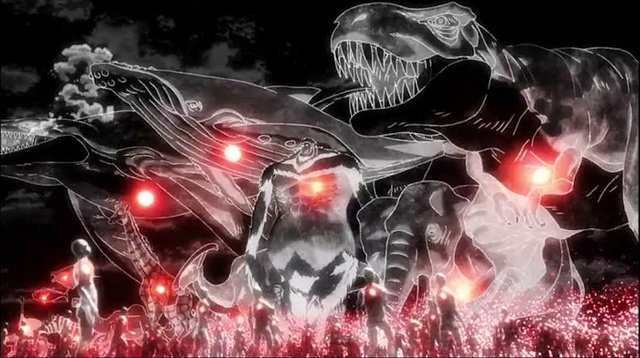
This week very interesting news were released (except for really stubborn creationists), as Science published an article on the very first account of documented evolution happening by hybridization right in front of scientist’s eyes!
Due to their isolated conditions and high specialization, finches from Galapagos Islands have been the subject of numerous studies regarding evolution – starting with the original observations from Charles Darwin that led him to postulate his theory of evolution by natural selection.
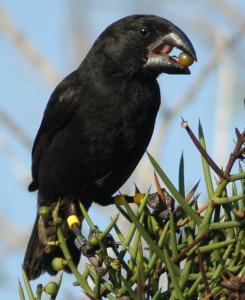
What happened in this instance, was that a male finch from a different species (and a different island) arrived into one of the islands and successfully managed to mate with a female of one of the resident species and produce hybrid offspring. Such offspring was fertile and continued to breed within themselves, until about forty years later they conformed their own population of about 30 birds that now differ in both shape and behavior from other species on the island – and furthermore, do not mate outside of their own group. This means that in only three generations, a new independent species managed to emerge! Which challenges the traditional view of evolution as being an extremely slow and gradual process.
This led me to the point that I want to discuss today: misconceptions about evolution and how it shaped life in our planet.
One book that really changed the way I thought about evolution was Wonderful Life: The Burgess Shale and the Nature of History, written by Stephen Jay Gould.
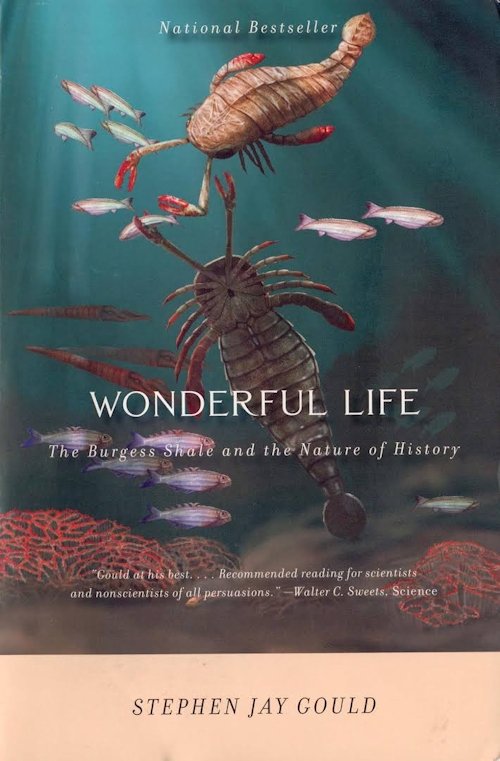
Gould was a Biologist whose stellar work focused on Evolution. He also produced some of the most enthusiastic, easy to read and engaging science essays, articles and books on the matter; Wonderful Life is a representative example of his brilliancy at presenting interesting, fact-based ideas in an educational but also entertaining manner.
In this book, Gould presents some very innovative, intelligent and well-researched ideas that aim at bringing down some misconceptions that many of us have had implanted throughout education and popular culture. These are some of them:
Misconception #1: Evolution = Absolute progress
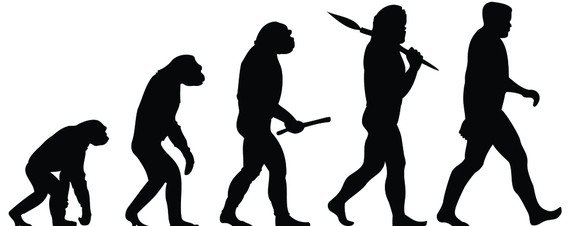
How many of us have seen the “march of progress”? That ubiquitous image showing monkey-like creatures walking in procession, progressively transforming into hominid shapes until finally reaching the triumphal Homo sapiens. Such image carries the pervasive connotation that evolution is a process of constant improvement; we can see plenty of it reflected in brand slogans, mottoes and often in inspirational advice:
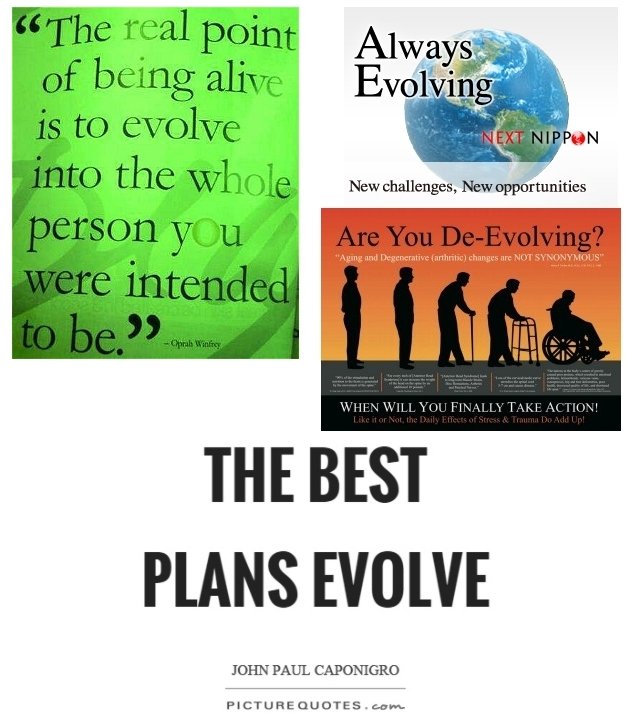
However, we might be overseeing the fact that evolution, as directed by natural selection, is just a process that brings success to species in a relative way; in other words, the perceived advantages provided by the evolutionary process are only so under very specific, limited circumstances.
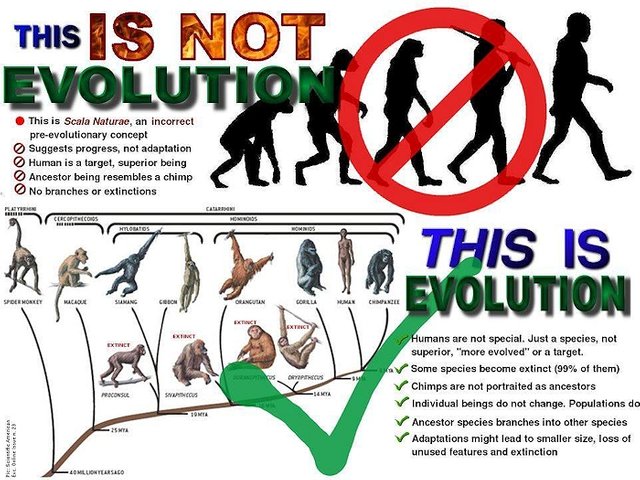
If we were to modify any of these circumstances, even a seemingly insignificant one, the species in question would probably not be successful anymore in such environment.
Gould opens up an even more provocative idea in this regard: he proposes an experiment in which we could “Rewind the tape of life”. This means, to start over again from the point of a barren Earth previous to the emergence of even the most primordial living beings, and let things develop and play all over again. Gould claims that if we were to do this while introducing minimal variations in the environmental circumstances, the resulting living organisms would be radically different from those we now know.
This is not only a thought experiment. Very interesting insights were obtained thanks to computer modelling, which boomed in the eighties regarding the development of different life simulation programs with different levels of complexity. People in the field referred to this as Artificial Life, which is a fascinating field on in its own, that opens many interesting scientific and philosophical questions, and will be the topic of a future post.
Still, I should note there is a counterargument of Gould’s proposed implications of “Rewinding the tape of life”. Daniel Dennett, another notable evolutionary biologist, affirms that some structures that are a product of evolution, like sensory organs, provide such a big advantage to their possessors over the other organisms and their environment that would invariably emerge at some point, which argues for evolution as a process with a defined direction.
Misconception #2: “The cone of increasing diversity”
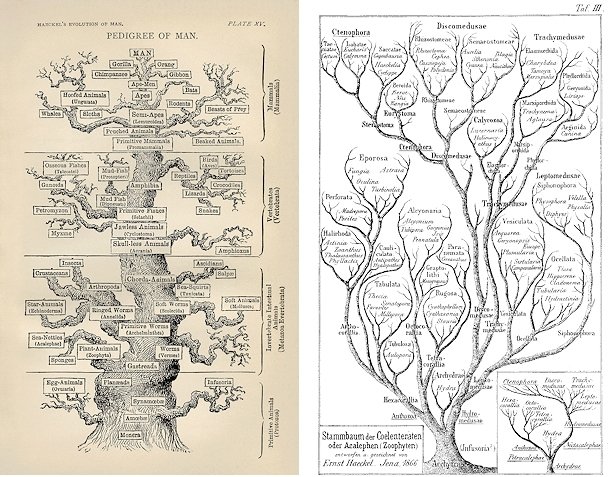
Many of us tend to think that through evolution we have reached now the greatest diversity of existing life forms and organisms. This comes from a very old tradition of thinking, influenced by the way the emergence of species was depicted by early evolutionary scientists. A prime example of this are the "evolutionary trees" shown above, sketched by Ernst Haeckel, an eminent biologist from the 19th century.
The “cone of increasing diversity” is a traditional view of evolution as a progressive diversity that branches out from a single, primordial form. However, the fossil record shows that in very early times (the so called “Cambrian explosion” 541 million years ago, or maybe even before that) a greater diversity was present in terms of “body plans” (i.e. the way an animal body is put together). Such body plans were so radically different to the ones we know on this day and age that they cannot be classified under any of the Phyla* we know.
Still, out this initial wealth of designs only a few were selected and the rest were discarded, truncating their future development.
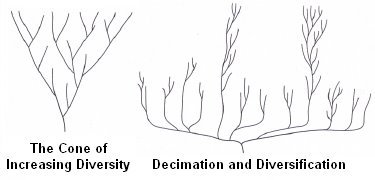
Hence, the diversity we observe now comes actually from variations of a limited repertoire of body plans (those which survived extinction); in other words, living organisms today represent only a few models (out of many more that existed millions of years ago) with a myriad of tiny variations that make each species unique.
*Note: Phyla is the plural of “Phylum”, and a Phylum is each one of the divisions of the different realms of nature; for example, within the animal kigdom, the Phylum Chordata represents cordate and vertebrate organisms (like us and most of the animals that are part of our diet).
Misconception #3: Evolution always goes from the simplest to the most complex.
Evolution does not have a completely defined, immutable direction, on the contrary, it acts according to the whims of environmental conditions at a certain time.
To understand this, we need to have a more global appreciation of life on Earth and pay closer attention to the mechanisms that result in the evolution of a species. Natural selection requires functionality that provides and advantage over the ever changing living conditions, which means that a complex organ that was useful but perhaps energy consuming, might not be required under certain conditions and actually burden the organism in a new environment.
In many cases, bodily structures have been simplified and specialized notably according to the environment an organism inhabits. One example of this are the legs of insects, which have derived from structures that were much more complex that disappeared through evolution.
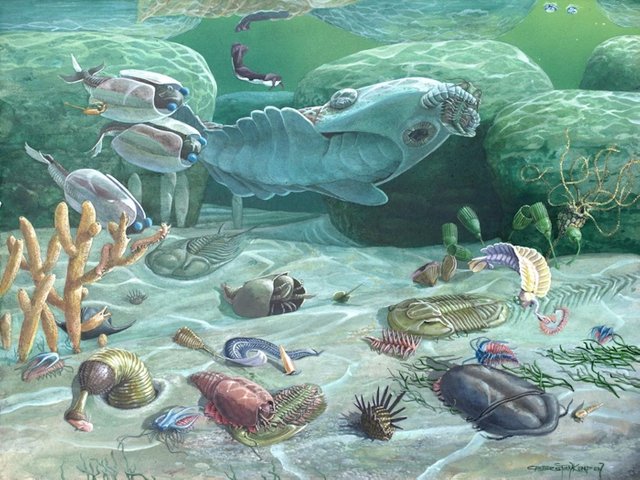

-------------------------------------------------
Image sources: All attributed above, except for the first one (bonus points to those geeky ones who recognize where I took it from! offer up your hearts!).
Couldn't one say that an experiment where a bacteria with no antibiotic resistance being put into an environment that selects for that and gaining a resistance be an example of evolution? An example of what I am talking about is here in this video here or watching the embeded link.
I'd say it's an example of the selection of a certain strain of a species.
The holy grail of proving that evolution exists, is to observe how a whole new species arises. A separate species usually cannot produce fertile offspring from mating with members of other species.
Holy grail? Isn't that Arthurian / religious nonsense?
Evolution has been proven to occur. As the vast majority of scientists will testify. And I think the phrase you're looking for is speciation, anyway. Evolution doesn't have to involve speciation.
"Holy grail" is a figure of speech and if you believe Dan Brown the original wording actually means "royal blood" ;-).
So yes, proving the evolutionary theory is definitely a royal deed. And to my knowledge, the Finch study that @irime describes is the first example where speciation (thank you for helping with the term) was observed, as this is one of the most decisive statements of the evolutionary theory.
While I strongly believe in the evolutionary theory, as it is so powerful to explain a lot of macroscopic, microscopic, cellular and molecular aspects of biology, I wouldn't say it has been proven. That is a hard thing to accomplish given that we can't time-travel.
There is a mountain of evidence. From the microscopic to the enormous, genetic to the palaeontological. Life once had humble beginnings. It's got a lot more complex since. The species roaming the earth have been shown to change with time (once dinosaurs disappeared, where did birds and mammals come from? Out of thin air - if you're religious?).
You could go into a courtroom and once you're through with the nonsense that is swearing on the bible, you'd be hard-pressed to find a jury of sane people that wouldn't unanimously accept the theory of evolution to be the way life works. Finding a suitable jury could cause a problem, I suppose, with the religion in the world. People will believe in their superstitious nonsense when it suits them. But they wouldn't be able to fly off on their holidays without inventors and engineers, nor would they be able be cured of their illnesses half the time, without the scientific community and the field of medicine. So, they'll also believe in science when it suits them, too. Some people are weird like that, eh?
What would you need to time-travel for by the way? Do 'religious' people need to time-travel to acquire their religion? Of course not, they just swallow myths passed down the generations. A myth that a lot would say was created simply to control people. Religious people are often the most unethical of people and anyone who needs a belief in god to keep them on the straight and narrow should be viewed with caution. If you're able to read a scientific text then you should be able to accept that for all intents and purposes evolution has been proven to be true. I'm sorry - not sorry - but it really is as simple as that.
Ps. I knew what you meant with the expression, 'holy grail'. I was just failing at being funny. :)
Didn't actually watch the video, but yes, kryzsec, bacteria do evolve resistance to antibiotics. That's why certain sexually transmitted diseases are on the increase, unfortunately (amongst other diseases). We mustn't beg our doctors for antibiotics unless we really need them. They shouldn't over-prescribe them, either. Farmers shouldn't be adding antibiotics to their feedstuffs, also
Because when the shit really does hit the fan....
I think you may have missed the point of my reply. I was asking if bacteria gaining antibiotic resistance would count as an example of evolution, not if it happened. Sorry for any confusion
Well, yes, it is evolution. As opposed to speciation (which is also evolution). Hence, I used the word 'evolve' in my first sentence above. (But I do appreciate the distinction you're making.)
Well, I also feel the phenomenon of 'co-evolution' might just be a serendipitous event, that is, it occurred by pure chance. The few evidences available are not just enough to establish it as a theory.
Surely, there are lots of examples of co-evolution? You have predator / prey relations including 'arms races', flowers / insects that have evolved to depend on each other (as opposed to more generalist relationships). Parasite / host relations, along with those of symbiotic species that continually co-evolve as well. There is stacks of evidence for co-evolution. 'Random' (non-directed) genetic mutations happen and natural selection acts on them. Those that natural selection favours spread through populations. If a trait proves favourable and spreads through a particular species, similar processes will take place in other life forms that routinely interact with it (or else the characteristics of the second species' niche will have to change). If something has a specialised diet and can't co-evolve to meet changes in its preferred prey, it has a good chance of going extinct. And species do go extinct, naturally. But many don't - due to co-evolution / evolving to interact with other species instead, successfully enough to sustain sufficient population sizes.
Life's all about co-evolving.
But don't you think the supposed coevolution might actually be as a result of different adaptive radiations that have nothing to do with relationships?
A very quick example off the top of my head and close to my heart...
The apple tree.
Why does it produce flowers? So that it can reproduce but pollen transfer isn't facilitated by the wind. Apples are insect pollinated. Insects get a reward by visiting the flowers in that they eat the nectar. The apple tree gets to reproduce when its pollen is taken to the flowers of other apple trees where it fertilizes an ovule.
Eventually, the ovules develop into seeds which are encased in juicy flesh: the apple. The apple falls off the tree and lands on the ground beneath the tree. As there's a tree already, it doesn't pay the original tree to have its offspring growing directly beneath it. Along comes a horse which likes the taste of apples. It eats it. All of it (seeds included). Then it toddles off and walks a fair distance whilst it digests its meal. Some hours / miles later, it egests its waste. The apple seeds are almost certainly not going to be competing with the parent tree. They land on the ground, covered in rich fertilizer waiting for that moment when they'll be stimulated to germinate. A new apple tree grows. That's life.
You could argue that's all down to 'pure co-incidence' but most people will laugh in your face if you do.
Look at the fossil record. Say, around the time that the flowering plants evolved and the age prior to their evolution. In rock of an age where such fossils can be found, what animal fossils would you expect to find? You're more likely to find flying insects here than in rock from a time before flowering plants. Why? Because they both co-evolved at the same time, to depend on each other.
Older rock would contain fossils of ancestral species that went on to evolve into flowering plants / flying insects that depend on them. But half the flying insects wouldn't have evolved if it weren't for the fact that certain plants went down the path of animal-pollination as opposed to wind pollination.
There are billions of other examples proving coevolution to be true. Evolution isn't your typical 'theory' any more. We're long past that stage. It's effectively law.
Why else would apple trees feed apples to horses? Out of kindness / stupidity? Why else do they produce nectar that is mostly eaten by flying insects and hummingbirds? Kindness? Stupidity?
They all coevolved to rely on each other.
Impressive explanation. But what happens if the apple is not the only thing the horse feeds on? What if the insect pollinates more than just the apple? Assuming the insect actually feeds and pollinates like 10 plants, will the insect evolve along with the 10 plants or just few?
Google 'the red queen hypothesis'.
You might like it.
I will :)
Thanks.
I think it still works, even if horses eat other things (which I think we both know is true, anyway). Because other animals like an apple on occasion, including primates including humans. Of course, many an apple will slowly rot never having attracted something to eat it and will slowly decompose where it fell. That individual is less likely to germinate and if it does is more likely to struggle and die an early death. But the system works on an evolutionary level, doesn't it? There are many an apple tree dotted across the planet. And the fruit they came from didn't all roll randomly to get to where the seeds germinated. They were carried. In bellies.
Finally, we must also remember life isn't about being 100% efficient or 100% perfect, is it? It really isn't about being anything, in fact. It just is. So long as the laws of physics that govern the universe aren't being violated, the thing works.
Regards insects, it's probably a little more complex (they reckon there's over a million named species of beetles, for example). Some plants are 'happy' allowing lots of different types of insect access to their precious pollen / nectar source. Likewise, some insects will not be that fussy about where they're getting their nectar from. Generalists. With a broad diet (in the case of the insects) and broad range of insects that get to carry their pollen (in the case of the plant / flower). Just as there are many, many generalists in both categories, there are lots and lots that are more specialised. Insects that only visit one type of flower (though the flower could theoretically be visited by other species of insect still). Plants that can only have their pollen carried by one species of insect (though the insect could theoretically still visit many other species of plant for its nectar needs). Finally, there'll even be the real close-knit relationship where a plant species exists that provides nectar to a species of insect that feeds 100% on its nectar.
The anatomy of a flower is designed (by nature that is, ie. through evolution) to accept insect visitors. Some flowers will and do allow just about any insect visitor in. Some flowers have a structure that is more restrictive preventing all but a single / few target species from getting to its nectar (and thereby, pollen).
Evolution has been happening for billions of years. We're talking incomprehensively vast numbers of individuals, some of which (in the case of insects, for example) having extremely short life cycles. Let your fruit flies escape in biology class at school and a few weeks later they could be trying to take over the school. Some such animals could see several generations being born in a year. So, in all those billions of years and with all the individuals of the species concerned, some of these interspecies relationships have really got in tune whilst others have gone wrong somewhere along the line. Take for example the orchid that mimics a bee. What possible advantage could the flower get from mimicking a bee? At a guess, I'd expect very few insects will visit them (thinking it's a bee and not a flower) but the ones that do, get to enjoy all the nectar (carrying away some of the plant's pollen, inadvertently, in return). One would have to presume it evolved from an ancestral species that also looked like a bee, an ancestral bee species, even.
Throw a load of shit against a wall and some of it will stick. It seems nature did and some of what stuck is a flower that looks like a bee. Remarkable, eh?
Anyway, it's tea time...
Yes! Thanks for this post! I cannot agree more with you. With your permission I would like to add an example to your article: A common misconception is that Evolution equals "moving forward". "Forward" related to what I ask?
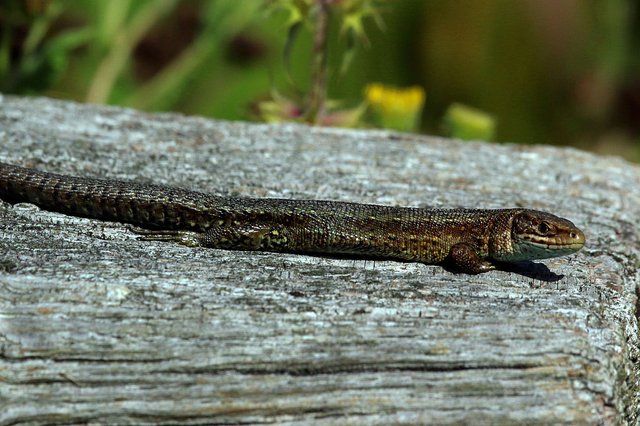
These species "went back" by laying eggs rather than "giving birth to young species", which totally breaks the Dollos Law.
Thanks again for the post! Resteemed and followed :)
Exactly! Also, the example of the lizard that you brought up here could also taken against Dennett's argument about evolution having a definite direction based on characteristics that provide some sort of "absolute" advantage.
Thank you very much for the follow and resteem, @dysfunctional! It is very much appreciated! :-)
You are very welcome :)
Excellent post!
I think very traditional people (religious I guess what I mean or just ignorant) may have misunderstood the process of evolution as a process which takes place in individual, like that an animal or human would grow a new functioning body part while s/he is living and then pass it on.
This is obviously wrong because evolution is a process that happens over generations. An individual animal doesn't change from lizard to human during its lifetime. Populations evolve, individual doesn't.
I guess the hyprids are their own species if they don't reproduce with other populations and they differ from other finches in their behavior and looks.
One definition for species is that two animals are different species if they cannot produce fertile descendants. By that those finches from different island weren't actually different species. But that could be a bit narrow view to look at it. And there are probably almost as many definitions for species as there are scientists.
You are right in your observation, @celestal, while looking for images for this post I came across this blog:
http://youdonthavetohaveaphd.blogspot.mx/2010/03/evolutionary-trees-actually-more-like.html
That's an example of how many religious people's arguments about evolution are nothing but misunderstandings about the fundamental principles of the theory. It also puzzles me how they seem to expect to find some sort of "half-baked" organism, some intermediate form of sorts between species? I really don't know what they mean since, well... all species have ancestors and also hold the potential to diverge into different ones...
I also find the concept of species confusing and I am starting to think that the term is a lot more fluid that we initially thought...
Thanks for this thoughtful input!
The greatest misconception is that evolution occurs in the absence of context and environmental pressure. All of the above misconceptions has this preconceived notion of evolution being some type of constant force without context. Nearly all mutations and phenotype variance are deadly and non-adaptable traits in the context of stable environments. Major environmental changes, like the oxygenation of this planet that killed-off virtually all life, result in evolutionary changes. In some sense, life is built upon the countless death of his forebears, and future life will necessitate the extinction of this world and her children.
Such and insightful and eloquently worded comment, @soo.chong163, I really can't add anything more.
It is very true that this idea of life evolving in a vacuum towards a certain goal (as if it was a running pre-programmed software) is pervasive somehow.
Thanks for stopping by!
Such an excellent post! This post is really worth the rewards. You did well to clear the misconceptions. I really like evolution topics and I can say you did justice to this topic...
Ride On...
Thank you for commenting :-)
This post carries a lot of things that we can learn from. Thank you for sharing this great concepts.
Glad to know it was useful (hopefully)!
the post is quite interesting@irime , amazing, your post makes me know more, greetings know @samsuel
Thanks!
Congratulations @irime, this post is the forth most rewarded post (based on pending payouts) in the last 12 hours written by a Superuser account holder (accounts that hold between 1 and 10 Mega Vests). The total number of posts by Superuser account holders during this period was 1198 and the total pending payments to posts in this category was $6869.28. To see the full list of highest paid posts across all accounts categories, click here.
If you do not wish to receive these messages in future, please reply stop to this comment.
great post.